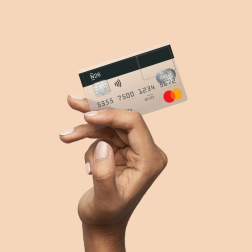
The rise of the gig economy has changed the way we work forever
This new way of working is transforming the way we live and bank.
7 min read
Thanks to the rise of the internet, the traditional workforce was already experiencing a major shift. Things like email and telecommunication made work more flexible and brought people together even faster. Now, during the COVID-19 pandemic, this tech-reliant way of working has been pushed even further.
Today, people have more options when it comes to supporting themselves—it’s no longer strictly necessary to rely on a classic 9-to-5 job to support yourself. Instead, people are able to be more creative and self-reliant when it comes to work, taking on shorter term work as wanted or needed. This way of working is known as the gig economy.
People have been working in the gig economy for years, but COVID-19 has caused interest in part-time and freelance work to spike dramatically. But is this a good thing? What are the pros and cons of gig work? Let’s take a closer look.
What is the gig economy?
The gig economy is a labor market made up of freelance or part-time jobs as opposed to full-time, fixed contracts. Gig workers can encompass a wide range of fields—from driving a taxi or delivery vehicle, to editing documents, to technical support, to performing artists. What makes a person part of the gig economy is not their background or chosen field, but rather the fact that they work on a short term, project basis, rather than as long term employees of one organization.
It’s also possible to join the gig economy while having a contracted job as an employee. For instance, you might work as a secretary or school teacher and take on a gig-based job like bartending or babysitting in your spare time to help supplement your income. Gig workers often wind up doing a much wider variety of tasks than employees that work full-time for one single company.
The bank you'll love

Gig economy jobs
According to McKinsey, some of the fastest-growing gig economy segments are in the creative and knowledge-intensive industries. For example, a graphic design studio could hire an advertising consultant to help them on a specific project, or a pizzeria could hire an expert copywriter to help them write a new menu.
However, beyond this model, modern tech companies are helping the gig economy to broaden its reach by connecting workers with consumers more quickly and efficiently. These organizations break the gig economy down into three components:
- Gig economy workers—people hired to complete a specific task or project
- Consumers—people or companies who require a specific task to be completed (i.e., a taxi ride, a new website design, or a delivery service)
- Companies linking workers directly with consumers—these are usually app-based platforms such as Uber or Fiverr, which create gig economy jobs based on the immediate demand
Why is it called the gig economy?
Fascinatingly, the term ‘gig economy’ finds its roots in jazz music. The term ‘gig’ was first coined in 1915 by jazz musicians to refer to their individual performances. It’s a term that’s now used by all genres of musicians, and even non-musicians.
When applied to this modern model of work, the term ‘gig’ is almost synonymous with ‘project’ or ‘flex.’ Essentially, it emphasizes the contained, one-off nature of the task at hand for which the worker—whether they’re a jazz musician, graphic designer, or something else entirely—is hired to complete.
The rise of the gig economy
More and more people are turning to the gig economy as a way to make extra cash, or even earn a living. But where did this meteoric growth come from? A few factors went into making the gig economy so easy to enter. Let’s unpack the main drivers behind the rise of the gig economy.
Budgeting made simple

The 2008 economic crisis
In the aftermath of the 2008 financial crisis, many people were either unemployed or underemployed. As a result, the demand for temporary work grew exponentially as individuals were looking for ways to replace or supplement their income.
Many people wound up holding several part-time or freelance jobs simultaneously, or combining a fixed contract job with a flexible mini-job on the side. As more people became familiar with the gig economy, gig work became normalized on a larger scale.
The rapid increase in digital technologies
Thanks to the internet, a gig worker is able to find work anywhere in the world. Physical geography is no longer a factor when it comes to finding the right people to work with—whether you’re a freelance illustrator looking for an author, or an agency on the hunt for an SEO specialist to help with a big project.
In addition, cutting-edge technology has resulted in the creation of digital, often app-based, gig economy platforms that link consumers directly with workers. Think of Uber, which connects drivers with someone who needs a ride, or Airbnb connecting hosts directly with those looking for a place to stay.
The global COVID-19 pandemic
Amid the global COVID-19 pandemic, gig economy workers have become essential for providing a sense of normality and keeping services running that otherwise wouldn’t have survived the crisis. From vital contactless food and medicine deliveries to online teaching services, gig workers have offered much-needed assistance during lockdowns all over the world. What’s more, as people lost their jobs or had their hours reduced, many turned to the gig economy to quickly supplement their lost income.
Today, it’s not uncommon to hear about individuals pivoting from working as a contracted employee in one field to being a gig worker in another. One prime example is live event organizers who have switched gears to organizing online conferences as needed, or content writers who had been employed full-time by one company and start freelancing for a range of clients.
The gig economy has even helped keep restaurants afloat that would otherwise have shut their doors forever during lockdown. While regular workers like servers and bartenders aren’t required during lockdown, delivery people have stepped in to help get food from the kitchen hungry customers. This helps keep chefs employed and lets restaurants pay their rent so that—with a little bit of luck—they will be able to open their doors again once lockdown is over. It also creates work for deliveries, thanks to a variety of different apps like Uber Eats, Deliveroo, and Wolt.
The pros and cons of the gig economy
While the gig economy has allowed millions of people to approach work in a completely new and empowering way, it does come with its downsides. Before entering the gig economy yourself, make sure you’re aware of the market’s pros and cons.
The advantages of a gig economy job
Working as a ‘flexi’ worker certainly comes with its benefits. For most people, these include:
- Low barriers to entry. Anyone can enter the gig economy, regardless of their skill set.
- Being able to adjust your own work-life balance.
- Flexible working hours, often with the choice to decide when to work and for how long.
- Having the choice of which kind of work and projects that you take on.
- The ability to work from anywhere around the world.
The disadvantages of taking a gig economy job
Consider the disadvantages of gig work before you sign any contracts, or decide to leave your long term employer for good.These disadvantages often include:
- Not having your pension, health insurance, paid sick leave, or paid holiday covered by your employer.
- Minimal job security with regard to redundancy packages or dismissal notice periods.
Gig economy platforms
As the gig economy rises, so do the online platforms that make finding work as a gig worker possible. These websites and apps act as direct links between gig workers and the peopl and companies looking for a particular service. They keep their business model lucrative by charging a minimal service fee for connecting these two parties. Many of these international platforms—including Airbnb, Deliveroo, Uber, Fiverr, and Amazon—are now some of the most profitable companies in the world.
Your money at N26
If you’re looking for a bank as flexible and modern as your professional life, you’re in the right place. If you’re part of the gig economy—whether you’re hiring workers or being hired yourself—N26 offers a range of business accounts, specifically designed to help support the self-employed. When you sign up for any N26 business account, you’ll enjoy cashback on every purchase you make with your debit Mastercard. Upgrade to Business Smart, Business You, or Business Metal to get access to even more innovative features, like Spaces sub-accounts. Spaces allows you to create up to 10 sub-accounts where you can organize your money alongside your main account. Set a recurring Rule to transfer money automatically, so you can save up for that special project without evening thinking about it. Check out all N26 accounts on our compare page to find the plan that’s right for you.
Find similar stories
By N26
Love your bank
How modern couples manage joint finances
6 min read
Related articles
These might also interest youBeyond Veganuary: How a greener diet could lead to a greener wallet
Reaping the financial rewards of a more plant-powered life.
How modern couples manage joint finances
Whether you’re polyamorous or monogamous, married with kids or parenting pets, money matters in every relationship. But the way partners organize their finances can differ greatly.
Women and financial literacy: Closing the gender gap
Financial literacy is a critical tool for women to build wealth and secure their future. However, many women lack the knowledge they need to get ahead. We explore why that’s the case!


